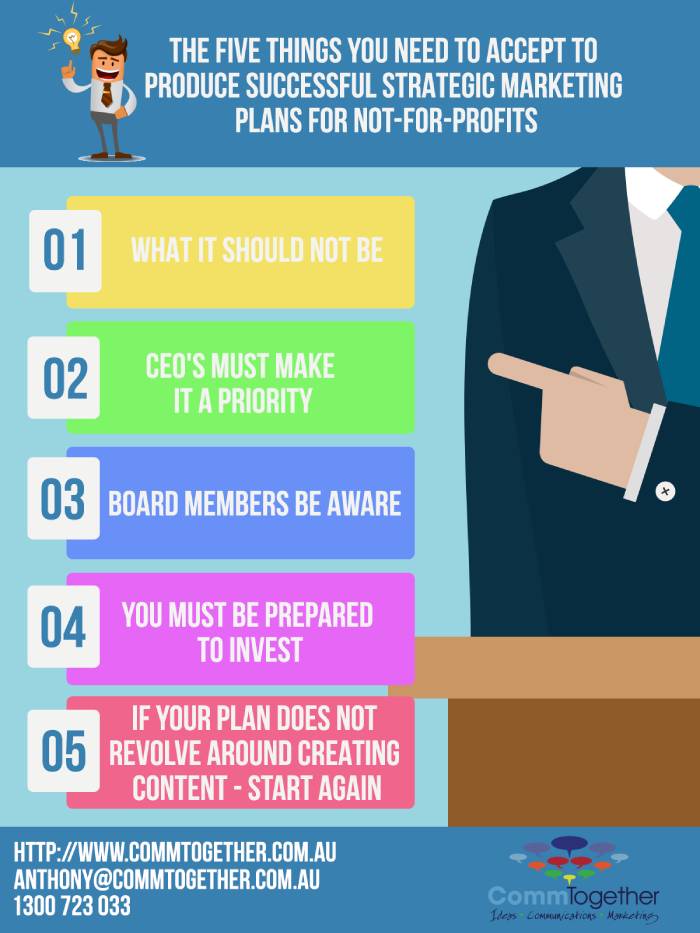
Strategic marketing plans for not-for-profits are more critical than ever, but far too often organisations get them wrong or Board’s move in a different direction in spite of the best advice given. We live in an age where communications mean everything for the success of your not-for-profit, you must embrace it as a long-term plan. With government shutting down funding streams or changing them to a more person-centred approach, it is only those with a strong will to follow a strategic marketing plan who will survive.
I am going to assume your foundations are correctly in place, which is a necessity before you start making any real strategic plans. I have written before about these basics, which no organisation can afford to miss. Once you have these basics in place, let the planning begin. Just in case you think are ready to skip straight to the plans, take advantage of our free e-book to guide you in the most important element of your plan.
The five things you need to accept to produce successful strategic marketing plans for not-for-profits
1. What it should not be
It is imperative to make sure strategic marketing plans for not-for-profits are NOT a long documented created by someone (internal or external) without buy-in along the way from key stakeholders. Do not undertake such a process and have the paper filled with items which will never be signed off. One of the greatest frustrations I have is hearing about an organisation who commissioned a marketing plan, they spent hours going back and forth on language, and then fail to act upon; to the shelf, it goes. If you have no intent of following through with the recommendations of the report, either it is not appropriate for you, or you are just not prepared for the next four points.
2. CEO’s must make it a priority
For a CEO it is easy to be caught up in; service/operational issues, fundraising, negotiating with the government, hiring people, finances, Board meetings, the list goes on. Where does marketing sitting for you if the question? If your CEO does not believe in marketing for not-for-profits, then you have a major problem. At a time when funding is becoming increasingly harder to maintain, you need marketing more than ever. With the shift towards a person-centred approach in so many areas already, marketing is what will make you stand out from your competitors, particularly the new businesses who come along. Marketing is part of a communications process, which should be a shared responsibility for everyone in the organisation. Right alongside the provision of services (or whatever it is your not-for-profit has been established to do), communications and marketing have to be a top priority.
3. Board members be aware
The biggest stumbling block for many not-for-profits is its boards. I have seen it time and time again. Well, meaning business people sit on the Board and think these community organisations should be run the same way as the multi-million dollar entities they work for during the day. There is a fundamental difference between the way this sector operates, and for a good reason. Far too often a Board expects multiple proposals (without paying for any), details of the smallest levels, and minimal amounts of spend with no risk. To make it worse, they always know someone who they think will do the job pro-rata. If you go down that path, always remember you get what you pay for and will never be the top priority. When a Board is getting involved at this level, there is a real danger that the project will be railroaded. I have seen organisations spend time and money working with experts only to see a Board claim to know it better. Without fail within a couple of years they live to regret the decision, which can sometimes be fatal for the organisation.
4. You must be prepared to invest
Marketing is not free. There are many components to implement a successful marketing strategy. If your not-for-profit is operating by spending a bare minimum on marketing, they will simply not survive long. You should be investing 5-10% of your gross income in marketing. Don’t confuse this with fundraising either; they are a separate area which requires some marketing. Between salaries/consultants, online tools, design, photography, printing, writing and a small amount of targeted advertising, your budget needs to be a reasonable amount. I am of the opinion, having worked in organisations, on boards and as an agency for them, the outsourcing model is by far the most efficient and cost effective. Even so, you need a decent budget.
5. If your plan does not revolve around creating content – start again
When it comes to building strategic marketing plans for not-for-profits, you need it to revolve around consistently creating content. That requires the cooperation of all staff because it is their expertise which will be a key. They don’t have to be writers, or suddenly lose hours of their time a week to generate content. Rather they have to be willing to give information, be it in dot points, supporting evidence or through an interview. The information they give will need to be in tune with what the audience you are targeting is after, which means it will not always be about the organisation (it’s events and services). You need to engage with people to enhance their sense of belonging to your community. This engagement becomes a powerful base for you to increase awareness of your brand and its messages.
Your plan needs to revolve around the idea that people are searching for information all the time. Years ago it was acceptable just to have a brochure which you could mail out. Now you need to be online. You need articles, social media, video, photos and graphics. All of it needs to be accessible whenever people need it.
The ultimate goal is to engage and grow your supporter base. By supporter, I mean anyone who does or could have a reason to support your cause, be it to use your services, volunteer to help, give financially or provide assistance to help enhance your ability to reach your targets. As funding avenues change or dry up from the government, those who will survive will be the ones with a strong brand and a strong community of supporters. If you are strong enough, government and the community will back the need which is clearly identified through the strength of support.
Strategic marketing plans for not-for-profits can only work if you follow all five of these points because otherwise, the writing is on the wall for the very future of your organisation.

Download the free e-book below and get your plans underway, and keep an eye out for a special offer which you can access with it.
